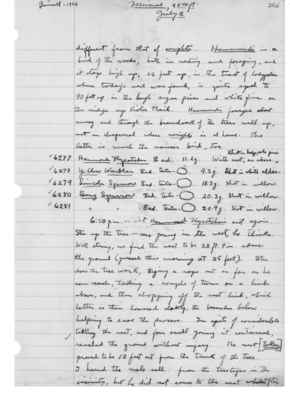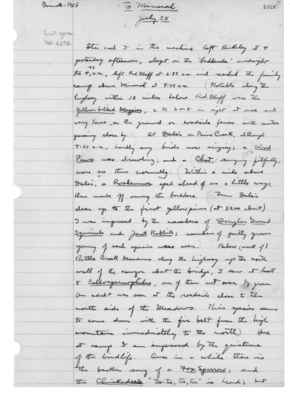Pages That Mention Stu
1925: Joseph Grinnell's field notes
S2 Page 62
Collector: Grinnell - 1925 Location: Mineral, 4800 ft. Date: July 2 Page Number: 2515
different from that of wrighti. Hammondi is a bird of the woods, both in nesting and foraging, and it stays high up; 25 feet up, in the tract of lodgepoles where today's nest was found, is quite equal to 90 feet up in the high sugar pines and white firs on the ridge up Viola Trail. Hammondi forages about among and through the branchwork of the trees well up, not in chaparral where wrighti is at home. The latter is much the noisier bird, too.
6277 Hammond Flycatcher [female symbol] ad. 11.2g. With nest, as above. ^Shot in lodgepole pine. 6278 Yellow Warbler [male symbol] ad. testes [testes illustration]. 9.2g. Shot in white alder. 6279 Lincoln Sparrow [male symbol] ad. testes [testes illustration]. 18.3g. Shot in willow. 6280 Song Sparrow [male symbol] ad. testes [testes illustration]. 20.3g. Shot in willow. 6281 [Song] [Sparrow] [male symbol] ad. testes [testes illustration]. 20.4g. Shot in willow.
6:50 p.m. - At Hammond Flycatcher's nest again. Stu up the tree - sees young in the nest, he thinks. With string, we find the nest to be 28 ft. 9 in. above the ground (guessed this morning at 25 feet). Stu does the tree work, tying a rope out as far as he can reach, taking a couple of turns on a limb above, and then chopping off the nest limb, which latter is then lowered slowly, the branches below helping to ease the process. In spite of considerable tilting the nest, and four small young it contained, reached the ground without injury. The nest [taken] proved to be 13 feet out from the trunk of the tree. I heard the male call from the treetops in the vicinity, but he did not come to the nest while after
S2 Page 75
Collector: Grinnell - 1925 Location: To Mineral Date: July 25 Page Number: 2528
Last spec. no. 6292
Stu and I in the machine left Berkeley at 4 yesterday afternoon, slept on the "badlands" midnight to 4:45 a.m., left Red Bluff at 6:15 a.m. and reached the family camp above Mineral at 9:45 a.m. Notable along the highway within 12 miles below Red Bluff were the Yellow-billed Magpies, 2 to 6 or 8 in sight at once and very tame, on the ground or roadside fences with autos passing close by. At Dale's on Paine Creek, although 7:30 a.m., hardly any birds now singing; a Wood Pewee was drawling, and a Chat singing fitfully, more so than normally. Within a mile above Dale's, a Roadrunner sped ahead of us a little ways, then made off among the boulders. From Dale's clean up to the first yellow pines (at 3200 about) I was impressed by the numbers of Douglas Ground Squirrels and Jack Rabbits; numbers of partly grown young of each species were seen. Below (west of) Battle Creek Meadows along the highway up the north wall of the canyon about the bridge, I saw at least 8 Callospermophilus, one of them not over 1/3 grown. An adult was seen at the roadside close to the north side of the Meadows. This species seems to come down with the fir belt from the high mountain immediately to the north. Here at camp I am impressed by the quietness of the birdlife. Once in a while there is the broken song of a Fox Sparrow; and the Chickadee's "tee-tee, too, too" is heard; but

